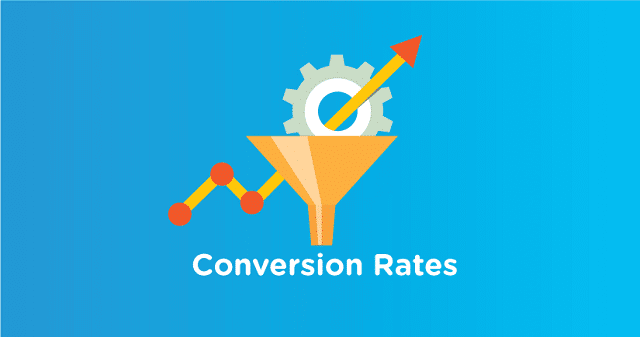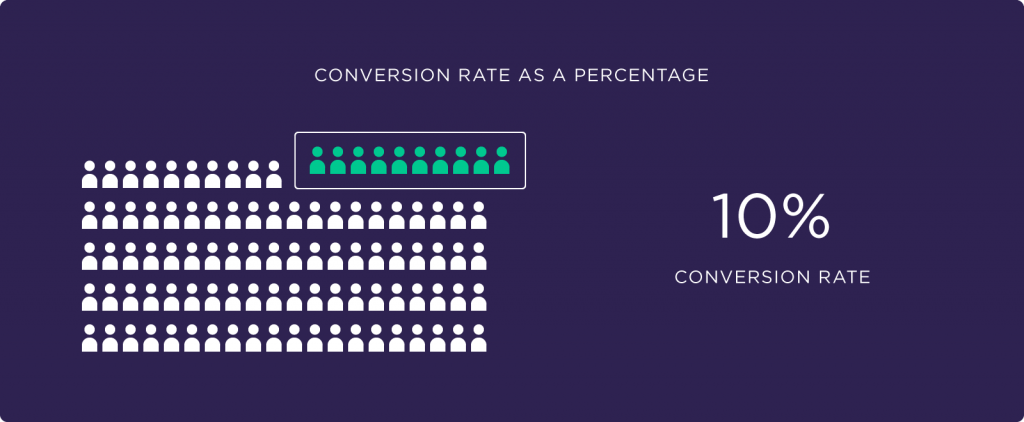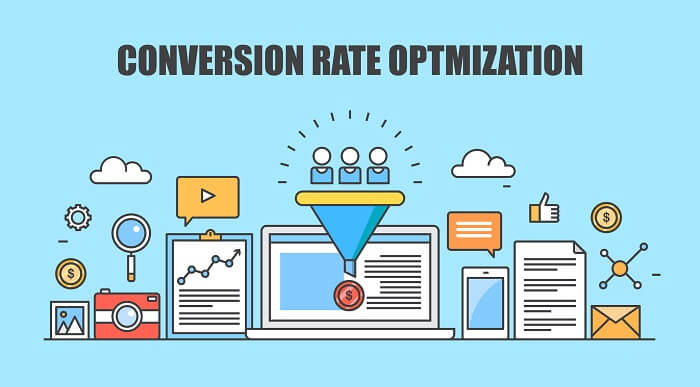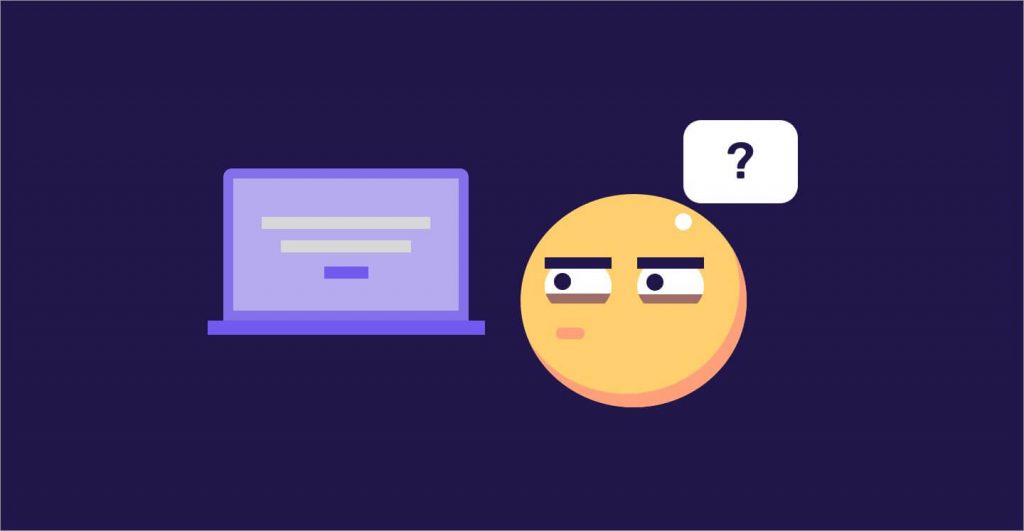When it comes to the conversion rate, you may think of a religious metric, yet it is one of the easiest ways to assess the advertising campaigns’ effectiveness.
Unlike click-through rate or cost-per-click, conversion rate shows how effective the marketing is at attracting users to do what you want them to do. In general, the higher your conversion rate, the greater your marketing!
In this blog post, we'll talk about what your conversion rate is, how to calculate conversion rate, and, most importantly, how to boost it.
What is the Conversion Rate?
The percentage of visitors to your website who complete the desired target (a conversion) out of the total visitors is referred to as the "conversion rate". A "conversion" could be almost anything depending on your business objectives, but here are a few typical forms of conversions:

- Buying something
- Filling out a questionnaire (contact us form, lead gen form, etc)
- Contacting your company
- Participating in your online chat
- Signing up for a paying or free subscription (such as a newsletter or a subscription plan)
- Signing up for the web
- Download things (software trial, eBook, mobile app, etc)
- Using something (new feature on your software, using your app, for a specified period)
- Upgrading their package.
- Actively engaging in some way with your website (repeat visits, time on site, number of pages visited)
There are many other conversion actions that people might perform on a website, but these can give you an idea of what a "conversion" is. In essence, a conversion is a measurable action that moves a prospective buyer one step closer to being a paid customer.
A high conversion rate means that people like what you're selling and can easily obtain it, which further indicates that your eCommerce business has great web design and marketing campaigns.
How to Accurately Calculate Conversion Rate
It is actually pretty simple when it comes to how to calculate conversion rates. Simply divide the number of conversions in a given time period by the total number of users who reached the web or landing page and multiply by 100 percent.
Conversion rate = (conversions / total visitors) * 100%
For instance, if your site had 17,492 visits and 2,305 conversions in the previous month, your conversion rate is 13.18 percent. Isn't it simple? In practice, if you set up your monitoring accurately, most online ads (e.g., Google Ads, Facebook Ads) and analytics platforms (e.g., Google Analytics) will show you your conversion rate directly in their platforms.

One of the best things about conversion rate is that it can be extremely precise or incredibly broad, depending on how you like to form it. Here are a few different forms of conversion rates to consider, as well as methods for analyzing results based on this data:
- Overall conversion rate (how effectively does the website transform traffic from any source?)
- Marketing channel conversion rate (does Google Ads traffic convert more than Facebook Ads traffic?)
- Page-level conversion rate (which of these pages converts more traffic?)
- Campaign conversion rate (did my targeting adjustments make a difference?)
- Individual ad conversion rate (does my ad copy need to be changed? Will this advertisement generate more qualified traffic?)
- Keyword conversion rate (which keywords should receive an additional budget?)
Obviously, this is just the tip of an iceberg. Conversion rate is an incredible indicator for measuring the efficiency of almost every part of your online marketing. Driving clicks is fantastic, but if those clicks do not result in beneficial action for your company, something needs to be changed.
#1 Click Conversion Rate
You might be wondering, "But what if the same person converts numerous times?" What impact does this have on my conversion rate? Do I consider it a single conversion or a series of conversions? How to calculate conversion rate then”
Those are all extremely good concerns. Marketers use different phrases to describe each circumstance when dealing with the “total conversions vs converting visitors” issue.
As previously mentioned, the conversion rate is calculated by dividing the number of conversions by the number of visitors. To calculate the proportion of visitors who converted (regardless of how many times they converted), divide the number of visitors who converted by the total number of visitors and multiply by 100 percent. This is often referred to as the "click conversion rate".
Click conversion rate = (converting visitors / total visitors) * 100%
Since many companies' conversion rates are nearly equal to their click conversion rate, we'll concentrate on classic conversion rates in this article. The click conversion rate, on the other hand, can be beneficial since you have a lot of repeat conversions and want to calculate what proportion of your real visitors are converting, so it is not a commonly used indicator. The majority of eCommerce businesses now still have small conversion rates (less than 10%), therefore the click conversion rate is not an optimal indicator.
#2 Sales conversion rate
You can calculate the sales conversion rate by specifying the “execution of a defined action” as the number of users who finished a transaction.
The sales conversion rate = the number of sales / total number of visitors (*100%).
Example of sales Conversion Rate calculation:
- number of sales = 100
- total visitors = 5.000
Sales Conversion Rate (SCR) = 200/4.000 = 0,05 * 100% = 5,00% SCR
This indicates that 5% of all your visitors make a purchase in your store. This measurement would be useful for particular groups of visitors as well. Visitors from search engines, for example (maybe through a special keyword). This will assist you in determining which marketing efforts were beneficial and which should be modified.
#3 Lead conversion rate
If you're not familiar with the word "lead," it's a way to obtain consumer contact info from someone who might potentially become a customer.
For instance, if anyone signs up for your email but hasn't bought anything from you, this person has a high likelihood of being a buyer in the longer term and should be nurtured or encouraged at any stage in order to be converted.
By looking at certain figures, you can calculate the lead conversion rate:
Lead conversion rate = number of converted leads /total visitors (*100%)
#4 Download rate
Is your website offering free material or other documents for download? How to calculate conversion rate then? The answer is to calculate the download rate of visitors to that site.
Download rate = number of downloads / total visitors (*100 percent)
#5 Micro conversion rates
To measure a micro-conversion rate, you must first specify a process and its steps. A simple definition of a sales process is: A simple definition of a sales process is: Click on the item to choose > Put to Cart > Buy > Complete order
By calculating the conversion rate of Basket to buy > finished order you will get the checkout abandonment rate.
Rate of checkout abandonment = number of sales (completed orders) / number of visitors in the checkout (*100%)
If your checkout procedure includes multiple phases, you can calculate a micro-conversion rate per each. So you can figure out if the guests are canceling their orders during the checkout stage.
How to Optimize Conversion Rate?
Fully understanding what a conversion rate is and how to monitor it is one thing, but then what do you do with all this data? More specifically, how can you increase the conversion rate when you have known how to calculate conversion rate already?

Conversion rate optimization (CRO) is the practice of optimizing your landing page and website to increase conversions from your existing traffic!
The best thing about CRO is that it enables you to make the most out of the traffic you already own. For eg, even if the number of visitors to your blog does not increase, increasing your conversion rate between 1% to 2% nearly doubles your conversions.
Can you see why conversion rate optimization (CRO) is such an impactful part of your online marketing campaign? You are bleeding your money if you are not maximizing your conversion rate.
#1 Add high-quality images and video on your product pages
Consider what you want to see if you go shopping. When you buy online, you can't touch or try on the items. The best thing you can do is provide a detailed video or photo so that the consumer understands exactly what they are paying for.
#2 Offer free shipping
Online shoppers often expect a certain standard that they have already experienced in Amazon.
In today's world, free shipping should be a must! Do you think you can't provide free shipping? Remember that this is basically a mind trick. If necessary, increase the price of your products to offset shipping expenses.
#3 Grant limited-time coupon codes
As the coupon code has an expiry date, it will create a sense of urgency. Therefore, shoppers are more likely to complete their orders without being distracted.
#4 Set a competitive price
If you sell brand-name merchandise just like many other retailers do, you should price your items at or below the average rate in order to get ahead. Make sure to make periodic pricing adjustments to see what works the best.
Also, market the brand to the right demographic, with the appropriate messaging and imagery, and the revenue will increase.
#5 Adopt cart abandonment software
If you have a high percentage of abandoned carts – that is, someone visits your site, adds an item to the cart, and then exits – abandoned cart software will significantly improve the store conversion rates.
This system is for users who have added products to their shopping cart, registered their email address and other details, but eventually decided to leave your store.
What If Your Website Receives High Traffic But Still No Conversions?
Creating your own website might be one of the most exciting aspects of your professional career. It's extremely difficult to throw your blood, sweat, and tears into a website, just to see a lot of traffic but no conversions.

If people are visiting but not purchasing from your website, there must be something wrong with it. Hence, you need to gain insights to improve the situation gradually.
If you are a do-it-yourselfer, there are two major ways to gain insight into your issue: analytics and real-world feedback. When it comes to optimization, Google Analytics can be your closest buddy, but your real-life best friends can also be valuable.
The idea of friends helping to improve your sales is pretty simple: just send your friends to your website and get them to deliver you real, honest feedback regarding your site. Even better if you have mates in marketing or related business background.
- ask their very first impression when landing on the site.
- ask their opinions on as many other things as possible. For example the text, the images, the products, the checkout process, the amount of information, etc.
Google, on the other hand, provides Google Analytics as a free service to anybody who owns a website. It gives you so many insights into how people communicate with your website, which is a must-have for any business owner.
Whenever the need to fix a paid funnel to increase conversions, people often do three things right away:
- On your landing page, build a heatmap. Look at where users click and where they don't click. They may often click on an element that does not have a link. This could be a simple fix.
- Create a scroll map to see when users leave the landing page. Shorten your page to that length and position your best CTA where people drop off. You can see a significant increase in conversions straight away.
- Analyze user recordings. Nothing beats observing actual consumer activity. What entices people to enter the funnel? Where are they intending to go? Leverage the user's natural inclinations as far as possible.
- Run a batch of A/B tests to identify and resolve any issues. Even, for your landing page, test 5-7 different headlines. This will easily result in a 30% improvement in conversions.
This will only take you 1-2 weeks to perform all of these steps and make your improvements live. This may be enough to fix your funnel.
Conclusion
Knowing how to calculate conversion rates and analyzing your various conversion rates will give you lots of valuable insights into what is happening with your design as well as how effective your marketing strategies are. If you've identified these problems, it's time to act and optimize it. Through soliciting feedback, making changes, and comparing your performance, you will undoubtedly increase your conversion rates in no time. Check out our Magento 2 extensions for the best conversion rate optimization of your eCommerce business.

















